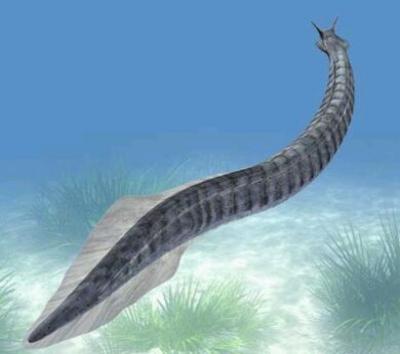- Joined
- Jul 11, 2008
- Messages
- 5,769
- Points
- 48
http://www.varsity.co.uk/news/4563
[h=1]Meet the ancestors: humanity traced to Canadian worm fossil[/h] Cambridge University scientists have confirmed the sea creature is the precursor to modern vertebrate life forms
by Emily Handley
Tuesday 6th March 2012, 15:19 GMT
Cambridge University scientists have just confirmed that a two inch-long sea creature may have been the first animal to show evidence of a backbone and vascular system.
 Pikaia gracilens, a two-inch-long worm-like sea creature, is the earliest-known animal to have the beginnings of a backbone, according to Cambridge University scientists
Pikaia gracilens, a two-inch-long worm-like sea creature, is the earliest-known animal to have the beginnings of a backbone, according to Cambridge University scientists
Whilst a tiny worm-like creature that existed half a billion years ago may not come top of your list when you think about who you share your genes with, this discovery is an important milestone in the search to find out how organisms evolved.
Pikaia gracilens, a sea-dwelling member of the chordate family, is thought to be the precursor of modern vertebrate life forms, due to the presence of a ‘notocord’, a flexible rod found in the animal’s back which would later transform into the spinal cord found in vertebrates today.
The design of the notocord also serves a crucial purpose, as it is surrounded by around 100 tiny blocks of muscle tissue, or myomeres, which are thought to have allowed the animal to propel itself quickly through the water by bending its body from side-to-side.
Fossils of the creature were first discovered in Canada in 1911, only to be stored in the Smithsonian Institute until the 1990’s when researchers returned to the site to find more specimens of the animal.
While the reasons behind the creature’s need to develop a backbone are not clear, it is thought that it may have needed to escape more quickly from predators.
Simon Conway Morris, the academic leading the expedition in Canada’s Yoho National Park, emphasised the importance of this discovery, saying: ‘Now with myomeres, a nerve cord, a notocord and a vascular (blood vessel) system all identified, this study clearly places Pikaia as the planet’s most primitive chordate.
‘So, next time we put the family photograph on the mantelpiece, there in the background will be Pikaia.’
Jean-Bernard Caron, one of Conway Morris’ co-authors, added: ‘it is very humbling to know that swans, snakes, bears and, incredibly, humans all share a deep history with this tiny creature no longer than my thumb.’
[h=2][/h]
[h=1]Meet the ancestors: humanity traced to Canadian worm fossil[/h] Cambridge University scientists have confirmed the sea creature is the precursor to modern vertebrate life forms
by Emily Handley
Tuesday 6th March 2012, 15:19 GMT
Cambridge University scientists have just confirmed that a two inch-long sea creature may have been the first animal to show evidence of a backbone and vascular system.

Whilst a tiny worm-like creature that existed half a billion years ago may not come top of your list when you think about who you share your genes with, this discovery is an important milestone in the search to find out how organisms evolved.
Pikaia gracilens, a sea-dwelling member of the chordate family, is thought to be the precursor of modern vertebrate life forms, due to the presence of a ‘notocord’, a flexible rod found in the animal’s back which would later transform into the spinal cord found in vertebrates today.
The design of the notocord also serves a crucial purpose, as it is surrounded by around 100 tiny blocks of muscle tissue, or myomeres, which are thought to have allowed the animal to propel itself quickly through the water by bending its body from side-to-side.
Fossils of the creature were first discovered in Canada in 1911, only to be stored in the Smithsonian Institute until the 1990’s when researchers returned to the site to find more specimens of the animal.
While the reasons behind the creature’s need to develop a backbone are not clear, it is thought that it may have needed to escape more quickly from predators.
Simon Conway Morris, the academic leading the expedition in Canada’s Yoho National Park, emphasised the importance of this discovery, saying: ‘Now with myomeres, a nerve cord, a notocord and a vascular (blood vessel) system all identified, this study clearly places Pikaia as the planet’s most primitive chordate.
‘So, next time we put the family photograph on the mantelpiece, there in the background will be Pikaia.’
Jean-Bernard Caron, one of Conway Morris’ co-authors, added: ‘it is very humbling to know that swans, snakes, bears and, incredibly, humans all share a deep history with this tiny creature no longer than my thumb.’
[h=2][/h]
